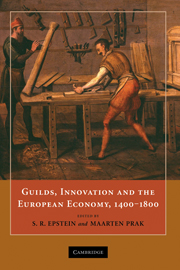Book contents
- Frontmatter
- Contents
- List of Contributors
- Acknowledgments
- Introduction: Guilds, Innovation, and the European Economy, 1400–1800
- 1 Craft Guilds, the Theory of the Firm, and Early Modern Proto-industry
- 2 Craft Guilds, Apprenticeship, and Technological Change in Pre-industrial Europe
- 3 Subcontracting in Guild-based Export Trades, Thirteenth–Eighteenth Centuries
- 4 Circulation of Skilled Labour in Late Medieval and Early Modern Central Europe
- 5 Painters, Guilds, and the Art Market during the Dutch Golden Age
- 6 Craft Guilds and Technological Change: The Engine Loom in the European Silk Ribbon Industry in the Seventeenth and Eighteenth Centuries
- 7 Guilds, Technology, and Economic Change in Early Modern Venice
- 8 Inventing in a World of Guilds: Silk Fabrics in Eighteenth-century Lyon
- 9 ‘Not to Hurt of Trade’: Guilds and Innovation in Horology and Precision Instrument Making
- 10 Reaching beyond the City Wall: London Guilds and National Regulation, 1500–1700
- 11 Guilds in Decline? London Livery Companies and the Rise of a Liberal Economy, 1600–1800
- Index
4 - Circulation of Skilled Labour in Late Medieval and Early Modern Central Europe
Published online by Cambridge University Press: 24 June 2009
- Frontmatter
- Contents
- List of Contributors
- Acknowledgments
- Introduction: Guilds, Innovation, and the European Economy, 1400–1800
- 1 Craft Guilds, the Theory of the Firm, and Early Modern Proto-industry
- 2 Craft Guilds, Apprenticeship, and Technological Change in Pre-industrial Europe
- 3 Subcontracting in Guild-based Export Trades, Thirteenth–Eighteenth Centuries
- 4 Circulation of Skilled Labour in Late Medieval and Early Modern Central Europe
- 5 Painters, Guilds, and the Art Market during the Dutch Golden Age
- 6 Craft Guilds and Technological Change: The Engine Loom in the European Silk Ribbon Industry in the Seventeenth and Eighteenth Centuries
- 7 Guilds, Technology, and Economic Change in Early Modern Venice
- 8 Inventing in a World of Guilds: Silk Fabrics in Eighteenth-century Lyon
- 9 ‘Not to Hurt of Trade’: Guilds and Innovation in Horology and Precision Instrument Making
- 10 Reaching beyond the City Wall: London Guilds and National Regulation, 1500–1700
- 11 Guilds in Decline? London Livery Companies and the Rise of a Liberal Economy, 1600–1800
- Index
Summary
Mobility of Pre-modern Skilled Workers
For a long time historians systematically underestimated the mobility of workers in pre-industrial Europe, on the assumption that individuals before nineteenth-century industrialisation and urbanisation were essentially place-bound. Social historians inspired by modernisation theory described the transition to modern society in terms of a radical increase in mobility – an argument that required establishing a counterpoint in terms of a spatially ‘stable’ and ‘immobile’ pre-modern society. As a survey from the 1970s put it, ‘there is widespread agreement that industrialisation, at least in Europe, caused an extraordinary spatial and occupational mobilisation, thereby marking a decisive break with static preindustrial society’. As Steve Hochstadt noted a few years later, ‘general works on economic history, family life, and social structure still describe preindustrial society as rooted…. Premodern Germans are still described as immobile in most general demographic studies. Even city populations are considered exceptionally stable…. Only with industrialization did German society become mobile’.
Although this view still finds some support, it was already becoming clear that migration was a ‘normal and structural element of human societies throughout history’. This revisionism soon extended to pre-modern Europe to include journeymen, as researchers discovered that a market for specialised labour had already begun to develop in the later Middle Ages, particularly in connection with the rise of organised tramping (Gesellenwanderung).
- Type
- Chapter
- Information
- Guilds, Innovation and the European Economy, 1400–1800 , pp. 114 - 142Publisher: Cambridge University PressPrint publication year: 2008
- 14
- Cited by



